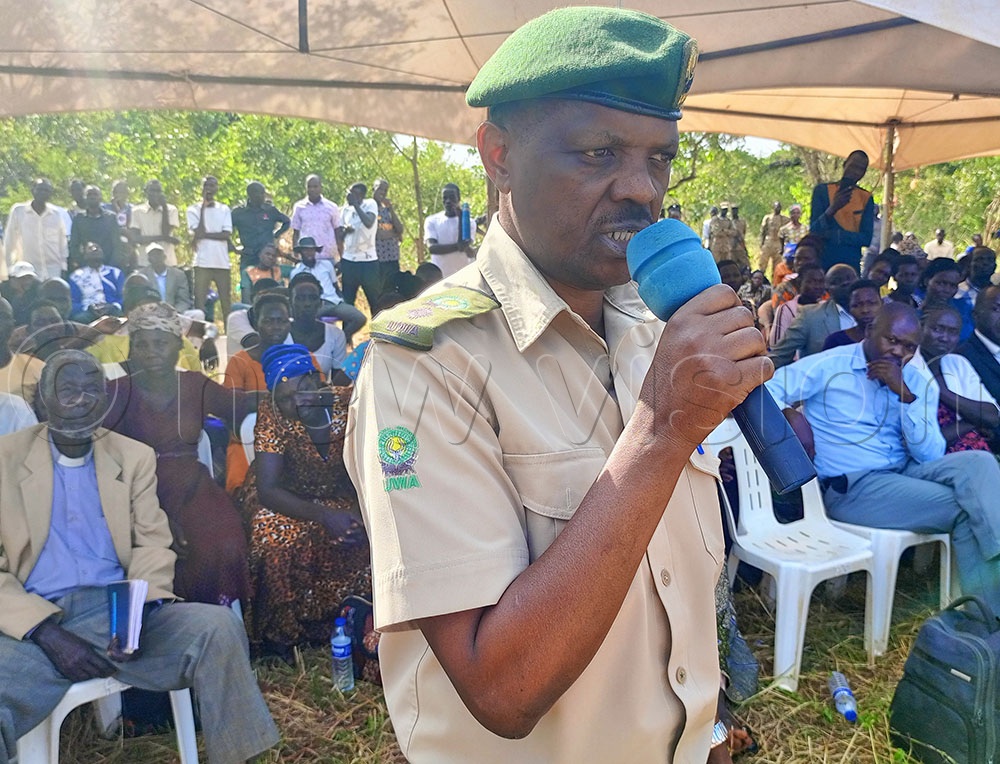Kidepo National Park electric fencing starts
Muhabwe disclosed that UWA has secured funding to construct a total of 100km of solar-powered electric fencing.
The fencing project, which commenced on October 23, 2025, has so far covered stretches 15 kilometres, according to Richard Muhabwe, Chief Warden of Kidepo Valley National Park. (Credit: Christopher Nyeko)
In a bid to curb the increasing human-wildlife conflicts caused by elephant invasions in communities neighbouring Kidepo Valley National Park, the Uganda Wildlife Authority (UWA) has embarked on the installation of an electric fence around the park .
The fencing project, which commenced on October 23, 2025, has so far covered stretches 15 kilometres, according to Richard Muhabwe, Chief Warden of Kidepo Valley National Park.
The exercise spans Lukori sub-county, Karenga sub-county, and Kidepo town council in Karenga district.
Muhabwe disclosed that UWA has secured funding to construct a total of 100km of solar-powered electric fencing.
“The sections that have already been fenced are showing positive results. Elephants are being deterred from entering community areas and are instead following the fence lines,” Muhabwe said.
The installation process involves bush clearing, pit digging, pole erection, and wiring. Once completed, the fence is expected to significantly reduce crop destruction and property damage that have long affected communities bordering the park.
Muhabwe added that plans are underway to extend the fence to the Karenga Community Wildlife Area to further limit elephant incursions into Orom, Namokora, and Kiteny sub-counties in Kitgum district.
The initiative follows a 2024 directive from President Yoweri Museveni, issued during a thanksgiving ceremony for state minister Lillian Aber, instructing the tourism ministry to fence off Kidepo Valley National Park.
Implementation had been delayed due to funding constraints, but has now been taken over by UWA management.
Communities neighbouring the park have for years suffered from elephant invasions that destroy crops and disrupt livelihoods.
Local leaders from Namokora, Kiteny, and Orom recently renewed calls for government intervention as elephants encroached deeper into community lands.
Received with optimism
Karenga deputy Resident District Commissioner (D/RDC) Ronald Ongodia confirmed the commencement of the project, noting that residents have received it with optimism.
“The communities are excited and hopeful that this fence will finally bring an end to their struggles,” Ongodia said. “Our office is closely monitoring progress to ensure the work is completed efficiently and on time.”
Once fully implemented, the fence is expected to promote peaceful coexistence between humans and wildlife while enhancing conservation efforts around Kidepo Valley National Park, one of Uganda’s premier tourist destinations.
Richard Muhabwe, the Chief warden of KVNP during the burial of the woman killed by an elphant last year in Namokora Sub county, Kitgum district. (Credit: Christopher Nyeko)
Construction of Kidepo International Airport underway
Muhabwe also revealed that construction of the Kidepo International Airport is ongoing. The project is being spearheaded by the Ministry of Works and Transport and the Ministry of Tourism, Wildlife, and Antiquities, in partnership with the United Arab Emirates.
The Sharjah Chamber of Commerce is overseeing the works, which began in July with site fencing.
“Work is being done on the runway and the fencing, as securing the airport’s perimeter is essential. Once completed, we will have direct international flights, which will coincide with the development of high-end lodges in the vicinity,” Muhabwe stated.
He projected that the number of tourists visiting Kidepo could surpass the 10,000 annual target once the airport becomes operational.
Reintroduction of white rhinos to complete the Big Five
In addition to the fencing and airport projects, UWA is working on a plan to reintroduce white rhinos to Kidepo Valley National Park. The move aims to establish the full complement of the Big Five—the Rhino, leopard, buffalo, lion, and elephant.
According to Muhabwe, a rhino sanctuary is already being established, with 17.9 kilometers of fencing completed.
“We anticipate having rhinos in Kidepo by the end of next year, starting with about 40 individuals, though that number may increase,” he said.
Road challenges hampering tourism
Despite these promising developments, poor road infrastructure remains a major challenge. Muhabwe cited the impassable Kitgum–Kidepo route as a key obstacle to tourism growth.
“We’ve raised this issue with the Minister of Works, and maintenance is ongoing, but it is not yet complete,” he reported.
He reminded the government of its pledge to tarmac the Kitgum–Kidepo road and to improve connecting routes through Moroto, Kotido, Kabong, Abim, and other eastern corridors.
“Improving these roads is crucial for boosting economic development and tourism. It would create numerous opportunities along the tourism value chain,” he emphasised.
Visitor numbers below target
Kidepo Valley National Park, consistently ranked among the world’s top safari destinations, fell short of its 10,000 annual visitor target last year by about 2,000 to 3,000 tourists.
For the 2024–2025 financial year, the park has so far recorded between 7,000 and 8,000 foreign visitors, mainly from Europe and the United States, who typically travel during the summer months of June to August.
Muhabwe attributed the shortfall to poor road conditions, which make the park difficult to access during the rainy season—coinciding with peak tourist periods.
He urged the government to fast-track the tarmacking of the Kitgum–Kidepo road, calling it “a vital tourism route.”
Currently, the park receives about two flights per week from Kajjansi Airfield, carrying an average of 16 visitors each.